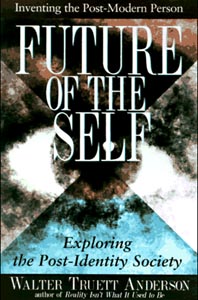
The Future of the Self: Inventing the Post-Modern Person
By Walter Truett Anderson
Jeremy Tarcher/Putnam; 288 pages; $24.95 cloth
Walter Anderson scouts the many manifestations of modern selfhood
By Paul Rosenberg
WHEN The Three Faces of Eve was published in the 1950s, multiple personality disorder (MPD) was an ultrarare, bizarre disorder. About 100 cases were known from 1791 (when first diagnosed) through the early 1970s. But nowadays, MPD is commonplace. This is but one--admittedly extreme--example of the various ways the traditional unitary self is coming apart.
Because we're accustomed to this ideal self, even far less extreme symptoms of change tend to be read as pathological. But in The Future of the Self: Inventing the Postmodern Person, therapist, writer and teacher Walter Truett Anderson argues that profound changes in what we take the self to be are predictable products of profound changes in our social world.
Traditional agricultural societies with their closed social worlds and stable social roles created social, role-defined concepts of self. Modern industrial societies created individual concepts of self, where internalization of values coalesces into an ideal of integrity as a unifying transcendent virtue. And now, Anderson argues, postmodern, postindustrial societies produce multiple, context-specific concepts of self.
Of course, this picture is too simplistic. Ancient traders crossing contexts between vastly different cultures would be ideal candidates for postmodern selfhood, and other exceptions can easily be found. But as a broad theory, Anderson's view has much to recommend it. For one thing, it provides a fresh, nonjudgmental perspective on the rapid-fire shifts in perceptions and prescriptions from 1950s concerns about corporate conformity to the neo-Romantic search for authenticity in the '60s and '70s to the fragmented, ironic sense of self increasingly evident today.
Anderson provides several sets of landmarks to map the changes he sees. The broadest set pinpoints two related aspects of the postmodern shift. First is a shift from self-as-subject, unconsciously merged with our ground of perception, to self-as-object, directly visible to us. Second is a shift from natural self--something to be discovered--to artificial self (not "artificial" in the sense of fake but in the sense of something created, an artifact).
Another set of landmarks coordinates terms already in use, beginning with three from postmodern psychology: multiphrenia, protean and decentering. "The first stresses our multiplicity," Anderson explains, "the second our changeability, the third the elusiveness of our own subjective consciousness."
In other words, we experience multiple selfhood at any one time in our lives; we experience radical changes in self-description through time; and we experience the self being created in the moment. Anderson then adds the relational self, a fourth characteristic drawn primarily from women's experience. In one respect (and arguably all four), women have been postmodernists all along.
A third, more concrete set of landmarks takes us into specific areas. There is a chapter on the brain, surveying a wealth of new ideas (multiple intelligences, distributed memory, etc.) that undermine the old concept of a single command center--and a chapter on the body that examines multiple parenthood, organ transplantation, plastic surgery, etc.
Then, Part 3, "Toward a Post-Identity Society," includes chapters on cyberspace, ethics, economics and politics. Here, though the insights continue to be apt and enlightening, they seem increasingly like random examples, not through any fault of Anderson's, but simply because the topics are too broad, and thus far lack clear prototypes.
Yet that's excusable in light of where Anderson ends up. His final chapter considers four possible scenarios of our future, combining models of technological and psychological progress or regress--and greatly enriching our grasp of possible alternatives.
His approach allows us to recognize three common alternatives: the low-tech/high-psych Unabomber utopia; the low-tech/low-psych fundamentalist retreat; and the high-tech/low-psych neoliberal future. But Anderson also examines a fourth, far less recognized high-tech/high-psych alternative, which he calls "One World, Many Universes." While The Future of the Self is provocative, enlightening and entertaining throughout, the presentation of this last alternative sets this book apart for people who routinely shrug off anything associated with the word "postmodern."
Anyone who thinks that talk about the self is abstract, subjective, self-absorbed or irrelevant should read The Future of the Self. Anderson's argument connecting the objective conditions of social life to the innermost experiences of the self couldn't end on a more pragmatic note.
[ San Jose | Metroactive Central | Archives ]
![[Metroactive Books]](/books/gifs/books468.gif)